Rust Family Foundation: Archaeology Grants Program
Neanderthal Death at Shanidar Cave, Iraqi Kurdistan
Principal Investigator: Graeme Barker
Disney Professor of Archaeology Emeritus and Senior Fellow
McDonald Institute for Archaeological Research,
University of Cambridge
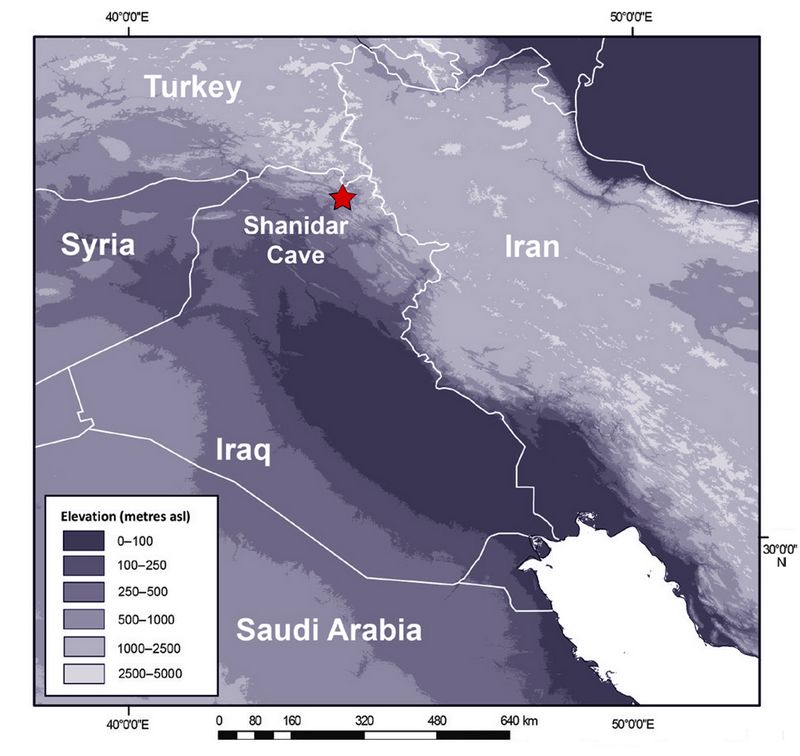
Shanidar Cave is an iconic site in Palaeolithic archaeology because of Ralph Solecki’s 1951-1960 excavations in Shanidar Cave, especially for his discovery in his 14 m-deep trench of one of the largest assemblages of Neanderthal skeletal remains. He argued that some of the dead had been killed accidentally by rock falls but that others had been deliberately buried with funerary rituals including one with flowers. His findings have been at the centre of Neanderthal studies ever since, continuously debated.
Fig.1: Location of Shanidar Cave.
Fig.2 (below): Shanidar Cave viewed from the south.
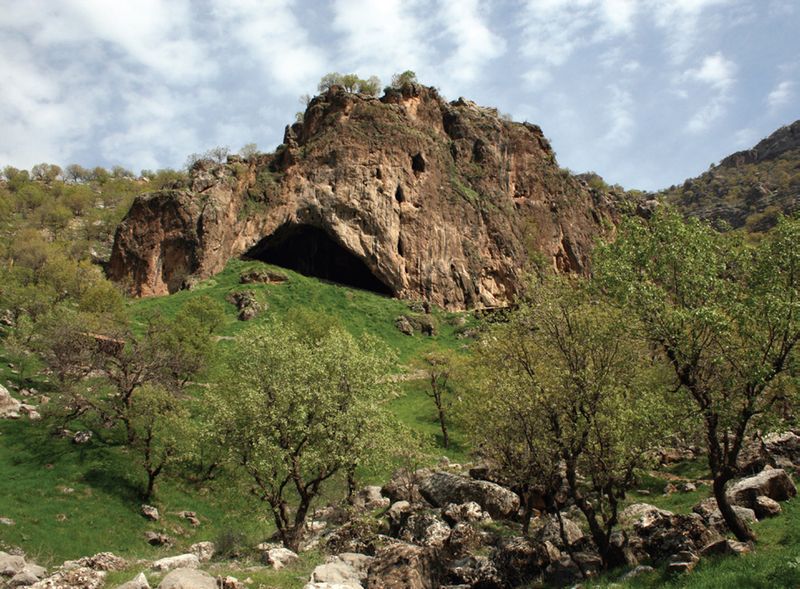 .
.Previous Research in the region
A Cambridge University team returned to the site in 2014. Despite having our first year’s fieldwork abruptly terminated because of the ISIS threat, in five seasons of fieldwork (the last one, in spring 2017, made possible by Rust Family Foundation support), we have been able to expose parts of the original trench walls down to 10 m. A suite of analyses using modern archaeological science not available to Solecki has shown that the sediments reflect major trends in global Ice Age climates from around 130,000 to 10,000 years ago.
2017 Funded Research Project (RFF-2017-22)
Goals:
The research objective was to undertake four weeks’ fieldwork in March/April 2017, and related post-excavation laboratory studies, to address the questions above about Neanderthal and modern human behaviour at the site.
The specific questions were:
• what were the climatic and environmental conditions in which Neanderthals and modern humans used the site?
• when were Neanderthals and modern humans at the site? (With the dating methods available at the time Solecki was only able to obtain general indications of the age of the Upper Palaeolithic ‘Baradostian’ occupation and a date of 40,000 years ago as a terminus ante quem date for the Neanderthal burials.)
• what behaviours did the two species exhibit at the site?
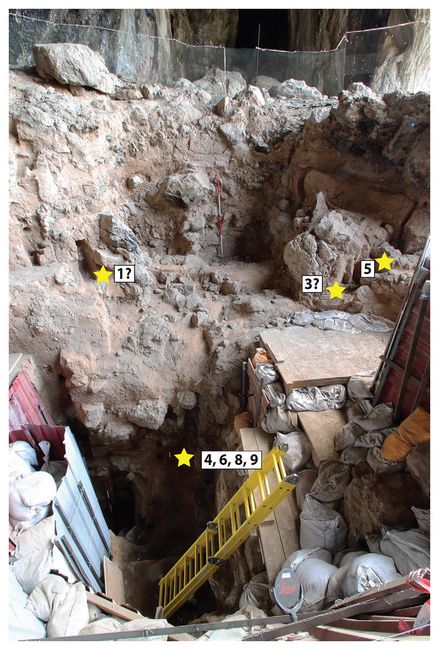
Fig.3: Photograph of the spring 2017 excavation, showing the confirmed location of the Solecki Shanidar 5 burial and the estimated locations of other burials; human bones have been found at the stratigraphical location of the Shanidar 4,6,8,9 burials. The Baradostian burnt layers and hearths (Fig.6) were located across the eastern extension above the Shanidar 1 and 5 burial locations.
Methodologies:
Most of the Neanderthal remains found by Solecki were located in the eastern extension of his 20 x 6 m trench, so the new excavations have concentrated on this area and the adjacent part of his main trench. Backfill that had accumulated during and after the Solecki excavations has been removed to expose the walls of his trench down to c.10 m depth (Fig.3). These were cleaned and recorded in the single context system, 3D recorded with a Leica C10 HDS Scan Station, and intensively sampled for material for dating and palaeoenvironmental reconstruction. The team consisted of c.12 specialist archaeologists, aided by Kurdish students and workmen.
The fieldwork has generated considerable materials for analysis, which has been and is being undertaken variously by project personnel and external specialists.
Findings:
Environment: Regarding the climatic and environmental conditions in which Neanderthals and modern humans used the site, initial 14C and OSL dates from the Oxford Research Laboratory indicate that the major changes observed in the surviving faces can be correlated with global climate phases known as Marine Isotope Stages (MIS). In the 2017 fieldwork sediments were exposed at 8–10 m depth. Four layers were found here suggesting considerable warmth and humidity interspersed with three layers indicative of cold arid conditions, suggesting that these sediments as a group likely belong to MIS 5, globally dated to c.130–71 ka (thousands of years ago).
There is evidence of oscillating climates in the overlying layers likely to date to MIS 4 (dated globally to 71–57 ka) and predominantly arid and cold conditions in MIS 3 (dated globally to 57–29 ka). Massive rockfalls on top of these sediments probably belong to MIS 2 (29–24 ka, the period of maximum glacial conditions). Erosion has resulted in an absence of significant deposits of sediments dating to MIS 1 (from deglaciation c.14 ka to the present) at the top of the sequence.
Dating of Palaeolithic occupations at Shanidar:
Baradostian: A series of occupation layers and associated hearths were discovered in this project associated with Upper Palaeolithic ‘Baradostian’ artefacts in the upper 2–3 m of the exposed sections (Figs.3,6). The initial 14C dates from Oxford indicate an age range of 45–33 ka, with several dates clustering at 43–38 ka. The Solecki archive indicates that similar occupation evidence and associated Baradostian lithics, food debris etc. were also found in adjacent parts of his trench. The Baradostian is recognised as a form of the Aurignacian, one of the earliest lithic industries made by modern humans in the Levant and Europe, so the makers of the Shanidar Cave Baradostian are assumed to be modern humans rather than Neanderthals, though there is no fossil bone evidence to confirm this.
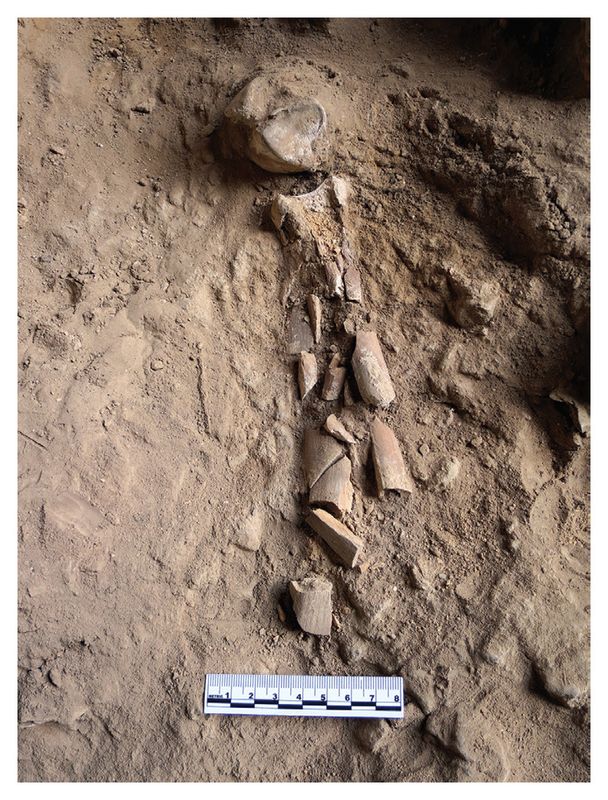 Neanderthal: An important goal of the project was to
establish the likely location of the Solecki Neanderthal burials in
order to date the sediments in which they were found, but an unexpected
and very important discovery of the new work has been of in situ human
bones likely to belong to the Neanderthal burials that Solecki
discovered at both the upper and lower burial locations (Fig.3). Using archive photographs and morphological comparisons, Dr
Emma Pomeroy has established that the new Neanderthal remains we
discovered at c.5 m depth, some articulated (Fig. 4), definitely belong
to the Shanidar 5 burial, a male estimated to be 40–50 years old
(Pomeroy et al. 2017).
Neanderthal: An important goal of the project was to
establish the likely location of the Solecki Neanderthal burials in
order to date the sediments in which they were found, but an unexpected
and very important discovery of the new work has been of in situ human
bones likely to belong to the Neanderthal burials that Solecki
discovered at both the upper and lower burial locations (Fig.3). Using archive photographs and morphological comparisons, Dr
Emma Pomeroy has established that the new Neanderthal remains we
discovered at c.5 m depth, some articulated (Fig. 4), definitely belong
to the Shanidar 5 burial, a male estimated to be 40–50 years old
(Pomeroy et al. 2017). Fig.4: Fragments of a human tibia and fibula in articulation with ankle bones near Solecki's Shanidar 5 Neanderthal skeletal material and confirmed as part of the same group; scale 8 cm; looking east.
Other bones have been found in section at c.8 m depth near the position of Solecki’s Shanidar 4 (the ‘Flower Burial’), 6, 8 and 9 individuals, together with what appear to be burial cuts (Fig. 5). Our 2017 field observations suggest that the latter are likely to be cultural rather than
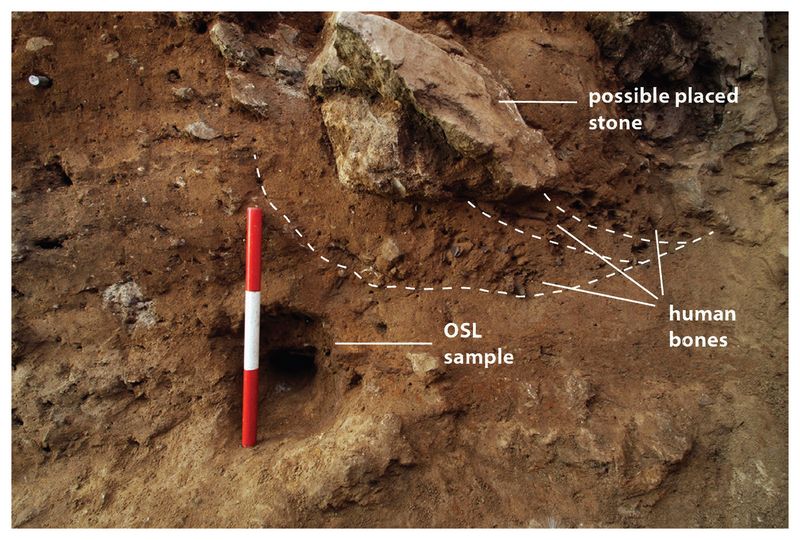 natural (an interpretation currently being tested
by micromorphological analysis of sediment blocks collected from this
zone in 2017), suggesting that there may be further burials to be
discovered in addition to those found by Solecki. There are also
indications of deliberately placed stones above some of the burials
identified by Solecki as accidental rock fall deaths.
natural (an interpretation currently being tested
by micromorphological analysis of sediment blocks collected from this
zone in 2017), suggesting that there may be further burials to be
discovered in addition to those found by Solecki. There are also
indications of deliberately placed stones above some of the burials
identified by Solecki as accidental rock fall deaths. Fig.5: Human bones at the stratigraphical location of the Shanidar 4,6,7,9 burials. Possible grave cuts are marked with dashed white lines. Scale: 30 cm.
The initial OSL and 14C dates indicate that the burials span a period from c.70 ka to c. 45 ka, across MIS 4 and 3, roughly the same time as Neanderthal fossil remains found in the Levant (Amud, Dederiyeh, Kebara, Tabun). Bone fragments from the upper and lower burials are being investigated for aDNA by Prof Eske Willerslev (Universities of Copenhagen and Cambridge).
Behavioral evidence of the two species at the site: Solecki’s descriptions suggest that there was a significant concentration of Middle Palaeolithic occupation evidence just below the lower burials that extended in smaller quantities down to c.10 m, with peaks in the humid phases. The makers of this material are assumed to be Neanderthal, though no hominin fossils were found. If correct, it would mean that Neanderthals were living successfully in the Zagros in the moist and warm
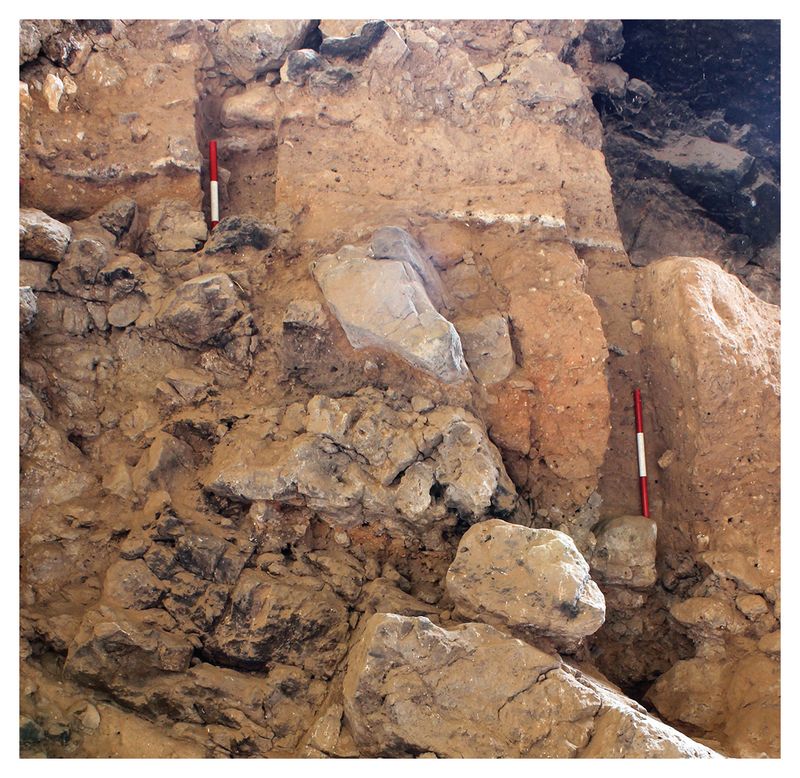 MIS 5, a time when present evidence suggests that only modern humans appear to have
been in the Levant. The lithic material studied in the US from this deposit (made from locally-available chert
and limestone) is suggestive of a broad range of subsistence activities
such as hunting, food processing, and hide scraping. They conserved their raw materials
and intensively repaired and resharpened their stone tools, suggesting
the long-term curation of tool-kits by very mobile populations who
visited the cave on a seasonal basis.
MIS 5, a time when present evidence suggests that only modern humans appear to have
been in the Levant. The lithic material studied in the US from this deposit (made from locally-available chert
and limestone) is suggestive of a broad range of subsistence activities
such as hunting, food processing, and hide scraping. They conserved their raw materials
and intensively repaired and resharpened their stone tools, suggesting
the long-term curation of tool-kits by very mobile populations who
visited the cave on a seasonal basis. Fig.6: Burnt occupation layers and hearths (white bands) associated with Upper Paleolithic ‘Baradostian’ artefacts, dated especially to 42,000-38,000 years ago.
Whether the pollen in the ‘Flower Burial’ represents flowers brought into the cave to accompany the dead, or was introduced accidentally on Neanderthal feet, or (as one study within the project has concluded) was most likely introduced by insects, it is notable that the flowers are all present in the brief spring flush at the site today, evidence of Neanderthal activity at the site favouring milder climatic phases and seasons.
The Baradostian occupations are also within brief episodes of milder climates within the predominantly cold and dry MIS 3. Until around 20 years ago the cave was occupied from November to April by transhumant shepherds who took their flocks to the high Zagros in the summer. The few seasonal indicators we have suggest that Baradostian hunter-gatherers likely used the cave in rather similar cycles of seasonal mobility. They camped in the cave and undertook activities such as food preparation and consumption and repair of hunting equipment. They used local m
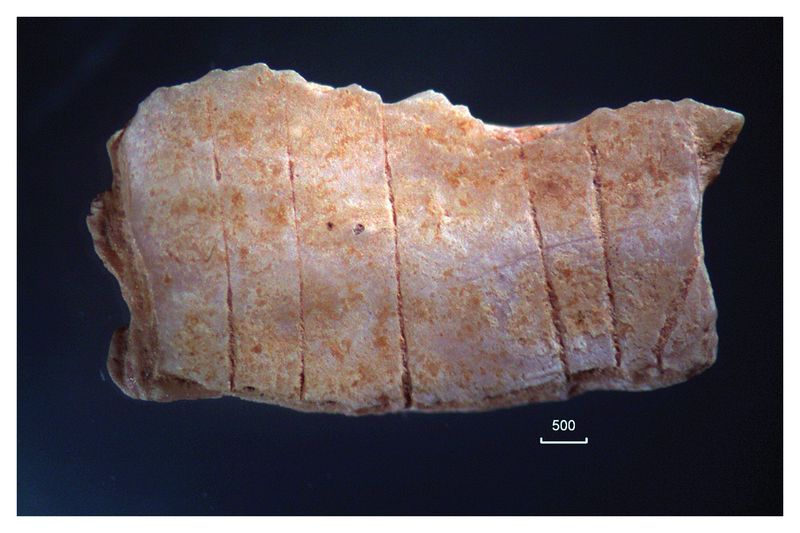 aterials
but also acquired exotic raw materials such as obsidian and crystal
quartz, the former transported from over 400 km away. The faunal sample
collected is small and extremely fragmented, but ibex appears to have
been an important prey. An incised shell is an intriguing example
of a non-utilitarian object (Fig.7). The cave then appears to
have been abandoned as cold and aridity increased significantly in MIS
2.
aterials
but also acquired exotic raw materials such as obsidian and crystal
quartz, the former transported from over 400 km away. The faunal sample
collected is small and extremely fragmented, but ibex appears to have
been an important prey. An incised shell is an intriguing example
of a non-utilitarian object (Fig.7). The cave then appears to
have been abandoned as cold and aridity increased significantly in MIS
2.Fig.7: Inscribed shell from a Baradostian occupation layer.
Conclusions:
Despite extremely daunting challenges (some political but most logistical), the new excavations have succeeded in meeting most aspects of our objectives. A considerable depth of the stratigraphy investigated by the original excavator has been explored. A preliminary palaeoenvironmental framework in relation to global climatic trends has been established through the last interglacial/glacial cycle from around 130,000 years ago to the Pleistocene/Holocene boundary 11,500 years ago. A preliminary chronological framework has been established for the hominin use of the cave that demonstrates its deep antiquity but also punctuated character, including as a place of deposition of Neanderthal skeletal remains c.70,000–45,000 years ago.
The data sets on Neanderthal and modern human behaviour are individually small but cumulatively are enabling us to build models of the very different ways in which these hominins used the cave. The longevity of Neanderthal presence through periods of major climatic change implies considerable versatility and resilience in their lifeways, and probably adaptations to the ecological mosaic of the Zagros that involved frequent but short-distance mobility. The timing of their disappearance from the cave remains to be established, but the stratigraphic indications are that there was little if any hiatus before the arrival of modern humans. An entirely unexpected bonus has been the discovery of in situ Neanderthal skeletal remains belonging to, or likely to belong to, the burials found by the original excavator, along with hints of further remains.
Publications:
Barker, G., 2017. A Tale of Three Caves: Why Was Our Species So Sucessful at Colonising New Environments? Amsterdam: Stichting Nederlands Museum voor Anthropologie en Praehistorie.
Fiacconi, M., 2017. Cave Pollen Taphonomy in Kurdish Iraq. Liverpool John Moores University, unpublished PhD thesis.
Fiacconi, M., & Hunt, C. O., 2015. Pollen taphonomy at Shanidar Cave (Kurdish Iraq): an initial evaluation. Review of Palaeobotany and Palynology 223, 87–93. https://doi.org/10.1016/j.revpalbo.2015.09.003
Fiacconi, M., & Hunt, C. O., 2016. Palynology of surface sediments from caves in the Zagros Mountains (Kurdish Iraq): patterns and processes. Review of Palaeobotany and Palynology 239, 66–76. https://doi.org/10.1016/j.revpalbo.2016.10.005
Hunt, C. O., & Fiacconi, M., in press. Pollen taphonomy of cave sediments: what does the pollen record in caves tell us about external environments and how do we assess its reliability? Quaternary International. https://doi.org/10.1016/j.quaint.2017.05.016
Hunt, C.O., Gilbertson, D.D., Hill, E.A., & Simpson, D., 2015. Sedimentation, re-sedimentation and chronologies in archaeologically-important caves: problems and prospects. Journal of Archaeological Science 56, 109–116. https://dx.doi.org/10.1016/j.jas.2015.02.030
Hunt, C.O., Hill, E.A., Reynolds, T., Abdulmutalb, D., Farr, L., Lane, R., Szabó, K., Barker, G., 2017. An incised shell object from Baradostian (Early Upper Palaeolithic) layers in Shanidar Cave, Iraqi Kurdistan. Journal of Archaeological Science: Reports 14, 318–322. https://doi.org/10.1016/j.jasrep.2017.05.057
Pomeroy, E., Mirazón Lahr, M., Crivellaro, F., Farr, L., Reynolds, T., Hunt, C.O. & Barker, G., 2017. Newly discovered Neanderthal remains from Shanidar Cave, Iraqi Kurdistan, and their attribution to Shanidar 5. Journal of Human Evolution 111, 102–118. http://dx.doi.org/10.1016/j.jhevol.2017.07.001.
Reynolds, T., Boismier, W., Farr, L., Hunt, C., Abdulmutalb, D. & Barker, G., 2015. New investigations at Shanidar Cave, Iraqi Kurdistan. Antiquity Project Gallery http://antiquity.ac.uk/projgall/barker348. Also published as:
Reynolds, T., Boismier, W., Farr, L., Hunt, C., Abdulmutalb, D. & Barker, G., 2016. New investigations at Shanidar Cave, Iraqi Kurdistan, in The Archaeology of the Kurdistan Region of Iraq and Adjacent Regions, eds K. Kopanias & J.MacGinnis. Oxford: Archaeopress, 369–372.
In preparation: papers on the age of the Neanderthal burials; the Upper Palaeolithic (Baradostian) use of the cave and its climatic contexts; the Mousterian/Baradostian transition; the Mousterian/Neanderthal use of the cave and its climatic contexts; obsidian sourcing and the techno-typology of the obsidian lithics; Mousterian and Upper Palaeolithic technologies at Shanidar Cave and their behavioural implications.
Recent Foundation grants: general Archaeology Grants Program w/map
Copyright © 2018 Rust Family Foundation